
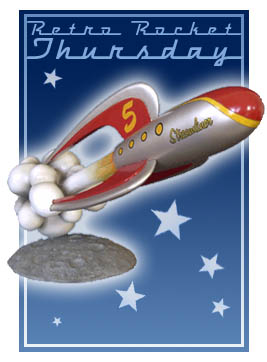
 Thursdays are Retro Rocket Days here at Webomator. Okay, who am I kidding? Every day is retro rocket day around here. But on Thursdays, it’s official.
Thursdays are Retro Rocket Days here at Webomator. Okay, who am I kidding? Every day is retro rocket day around here. But on Thursdays, it’s official.
Today’s blast from the past is actually called the Blast Rocket . It’s one of Jeff Brewer’s amazing rocket statues in cast resin, with a weighted base and just about the perfect puffy cloud of exhaust.
. It’s one of Jeff Brewer’s amazing rocket statues in cast resin, with a weighted base and just about the perfect puffy cloud of exhaust.
7.5″ tall and 11″ long, it’s meant to sit on your desk and show everyone that you’re headed off to the asteroid belt right after work. In style.
This entry was posted on Thursday, August 30th, 2007
and was filed under Found on the Web
There have been no responses »


It’s still early in the year, unless we’re really planning ahead – but for the first time I’ve added calendars to my Celtic Art & Retro-Futuristic Design site.There’s a Celtic Art Calendar with twelve of my original knotwork designs. They’re what you might call eclectic, including a knotwork biohazard symbol, a Chaos Star design, a Skull and Crossbones and a few more traditional designs like my “Tanglewood” and “An Claidheam Soluis” pictures.
On the Retro-Futuristic side, my 2008 Retropolis Calendar offers twelve months of retro rockets, faithful robots, flying cars, and death rays. Sort of an early indicator of the year we have to look forward to. Hint: be prepared to duck.
And on a tangential note, my Retrovert site also has a couple of WPA poster calendars (Travel Posters and Health & Safety Posters) and one with covers from vintage Modern Mechanix & Inventions magazines.
This entry was posted on Wednesday, August 29th, 2007
and was filed under Works in Progress
There have been no responses »

“Pest Control” is an animated music video by Peter Leary and a crew of co-conspirators, using Me the Conqueror’s Lo Fi as the setting for an insect rock concert that leads to, well, insurrection. Or something like it.
Really nicely executed in every way. While it’s not new (2005), it does seem to be new to the web. Therefore, go watch it.
This entry was posted on Tuesday, August 28th, 2007
and was filed under Computer Graphics, Found on the Web
There has been 1 Response »
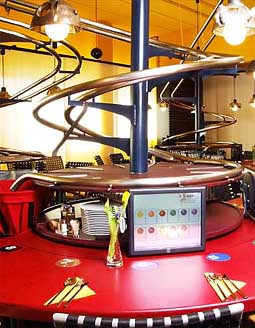
Shades of the future that never was! A restaurant in Nuremberg has done away with waiters (in a completely humane way) by replacing them with a gravity-feed system and networked computers at every table.
The kitchen’s above the dining room. Customers order using touch-screen computers at their tables, and when their food’s ready it slides down gently on spiral rails.
I suppose that to complete the circuit you’d want more rails leading to dishwashers in the basement, but for now it looks like the jobs of buspersons are secure. More here.
This is somehow like the automated parking garage that was designed in Germany a couple of years back. A trend in vertically oriented job reductions?
This entry was posted on Monday, August 27th, 2007
and was filed under Found on the Web
There have been no responses »
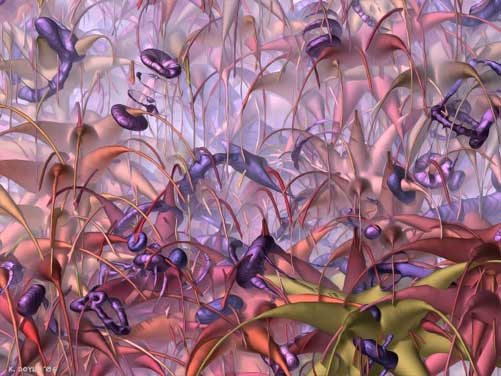
And speaking of the old Amiga days, here’s one of a series of beautiful abstractions by Keith Doyle.
Keith wrote one of the most useful applications I used on the Amiga (“the Director” – a few years before Macromedia fastened on that name). The Director was a version of the BASIC programming language which included powerful extensions for 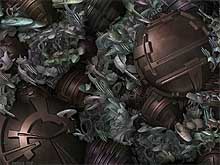 displaying and manipulating graphics and sound. Keith’s always been interested in both art and music.
displaying and manipulating graphics and sound. Keith’s always been interested in both art and music.
Here we see what he’s been up to visually. Many of these images use kaleidoscopic reflections, but others are asymmetrical and nearly representational. Although the scenes they seem to represent are places I haven’t visited since the late seventies. Ahem.
Great stuff!
This entry was posted on Thursday, August 23rd, 2007
and was filed under Computer Graphics
There have been no responses »
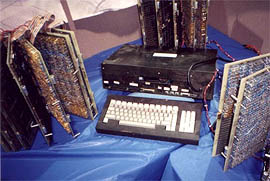 Ars Technica’s History of the Amiga continues with Part 3, in which we finally meet the rest of Amiga Inc.’s team – including R.J. Mical, Carl Sassenrath, Dale Luck, and Dave Needle.
Ars Technica’s History of the Amiga continues with Part 3, in which we finally meet the rest of Amiga Inc.’s team – including R.J. Mical, Carl Sassenrath, Dale Luck, and Dave Needle.
The group is under the gun as they prepare for their computer’s first private showing at CES in 1984. At left we see the prototype of the machine, with each of its three custom chips emulated by enormous breadboard sandwiches.
The operating system is well under way, with Sassenrath’s lean multitasking kernel and Mical’s work on the UI and its interface for developers. But as they near the point where they’ll have an actual product to sell, they’re running out of money. Go forth and reminisce.
This entry was posted on Thursday, August 23rd, 2007
and was filed under Computer Graphics
There have been no responses »
 A paper from this year’s SIGGRAPH by James Hays and Alexei Efros (Carnegie Mellon) takes a new approach to digital image “healing” or hole filling. This is a problem faced in many situations, whether it’s restoring a damaged picture, eliminating flaws like a bug on the lens, or just replacing unwanted areas of an image – picture, for example, a plate for a motion picture backdrop in which the makers of a period film want to eliminate modern details.
A paper from this year’s SIGGRAPH by James Hays and Alexei Efros (Carnegie Mellon) takes a new approach to digital image “healing” or hole filling. This is a problem faced in many situations, whether it’s restoring a damaged picture, eliminating flaws like a bug on the lens, or just replacing unwanted areas of an image – picture, for example, a plate for a motion picture backdrop in which the makers of a period film want to eliminate modern details.
What makes this technique unusual is that it doesn’t look for other areas in the image for texture and detail to insert. The software that the authors developed uses a database of 2.3 million unique photographs and – without human intervention – looks for semanitic matches for the area that they chose to replace.
No human tagging or hints were used. The program looked over the entire database for broad matches, then looked more carefully for the best fit. When finished (after about an hour on a single CPU, or five minutes on a cluster of fifteen), the authors were presented with several results to choose from. Their paper shows how completely different those results often were, which is one of the most interesting aspects of the algorithm. They also show us examples of bad matches, in which existing methods provided better results than theirs.
Overall the results are impressive, especially considering that the software has to figure out a lot about the images it’s “looking” at in order for this to work. The larger the database, the better it does.

I think that there are some inherent problems with actually using this sort of technique. Their huge database was acquired from Flickr accounts and so there would obviously be copyright issues; also, because some of the solutions include people – even crowds of them – a commercial use could produce photographs of people without model releases, or even any way of knowing who the heck ended up in the picture. And because it’s hard to figure how else you could assemble a library of millions of source photographs, I think that’s a pretty large hurdle to jump. Still, very interesting.
This entry was posted on Monday, August 20th, 2007
and was filed under Computer Graphics
There have been no responses »
 Here’s something I think is pretty fun, even though I can’t exactly wear it myself – women’s T-shirts for the “Retropolis Ladies’ World Domination Society”.
Here’s something I think is pretty fun, even though I can’t exactly wear it myself – women’s T-shirts for the “Retropolis Ladies’ World Domination Society”.
Sugar, Spice, and complete, uncompromising oversight over everything that goes on in the Future That Never Was: that’s the chemical composition of the Ladies’ World Domination Society. Also, they serve tea.
Their motto is “Don’t MAKE me come down there!”
Available (on different selections of shirts) at both the Retropolis Transit Authority and at Celtic Art & Retro-Futuristic Design. Be the first on your block – I just finished ’em today.
This entry was posted on Sunday, August 19th, 2007
and was filed under Works in Progress
There have been no responses »
These don’t happen too often – they’re fairly complex undertakings – but I’ve just added a new Retropolis poster to my Celtic Art & Retro-Futuristic Design site.

This scene – a sort of car show of the Future That Never Was – showcases one of the rockets I modeled for my Empire State Patrol project. Here I changed its color and dropped it into a variation on the scene I built for my “Skin A Scion” contest entry at Deviant Art.
The poster (18 by 24 inches at 300 DPI) mixes some older and newer characters together, and its title – “If I Only Had Wings, I’d Fly” – marks the second time I’ve named a picture with a quote from Nat Gonella’s “It’s a Pair of Wings for Me”, which still swings after about 66 years. Love that song – and in fact, though I’ve never known how many people noticed, almost all my Retropolis pictures use titles or quotes from popular music of the twenties through the forties. If you figure out why, you can explain that to me.

The poster is available now. An archival print should be available in a few days.
This entry was posted on Friday, August 17th, 2007
and was filed under Computer Graphics, Works in Progress
There have been no responses »
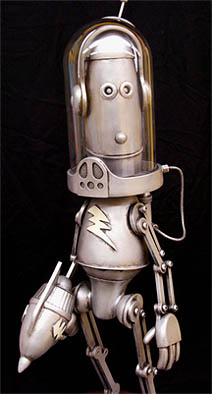 Lawrence Northey’s sculptures of robots, rockets, and ray guns (oh my!) are what you’d have to call out of this world.
Lawrence Northey’s sculptures of robots, rockets, and ray guns (oh my!) are what you’d have to call out of this world.
Like the artists who created the Faberge eggs he admires, Northey uses a variety of materials and techniques. Most of these pieces feature brass, stainless steel, and glass. Sometimes cast aluminum or cast resin parts are also used, typically hand painted to give a uniform finish with the other parts.
While most of these pieces are pure sculpture, in sizes around thirty inches in heght, there’s also the amazing “Dave the Robot Lamp”, which lights up in eerie warm colors – pretty dang extraterrestrial, in fact.
Northey does commission work as well as selling made-to-order series – like “Dave the Robot“, at right, and the cast aluminum “Silver Edition Raygun“.

One of the fascinating things about these works is that although they’re obviously inspired by retro-futuristic toys from the 30s through the 50s, they’re made with exacting craftsmanship and detail that recalls early European art deco objects. Consequently you’ll find that they’re priced as artworks, not knicknacks. Judging by the samples on his site they’re worth every penny.
Some of his commissioned work is animatronic – lighting up. moving, and making sounds, even music. And like your chronically project-obsessed correspondent, he’s tying these characters and ideas together into a story which he calls “Wired City”.
Not to be missed!
This entry was posted on Thursday, August 16th, 2007
and was filed under Found on the Web
There have been 2 Responses »


Thursdays are Retro Rocket Days here at Webomator. Okay, who am I kidding? Every day is retro rocket day around here. But on Thursdays, it’s official.
. It’s one of Jeff Brewer’s amazing rocket statues in cast resin, with a weighted base and just about the perfect puffy cloud of exhaust.



















 Here’s something I think is pretty fun, even though I can’t exactly wear it myself – women’s T-shirts for the “Retropolis Ladies’ World Domination Society”.
Here’s something I think is pretty fun, even though I can’t exactly wear it myself – women’s T-shirts for the “Retropolis Ladies’ World Domination Society”.





